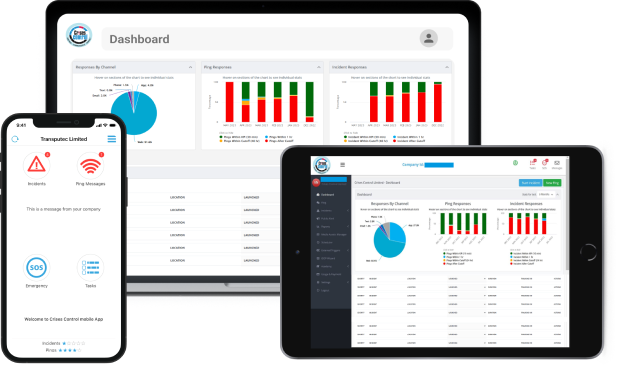Written by Sonny Sehgal | Board Member
In today’s unpredictable world, businesses must be prepared to handle a wide range of crises, from natural disasters to cyber-attacks and everything in between. OnSolve has long been recognised for its robust alerting capabilities, helping many organisations effectively communicate during critical events. Its ability to deliver timely alerts is a strength that has served numerous companies well in managing urgent situations.
However, as organisations seek solutions that offer enhanced usability, advanced features, and better value for investment, Crises Control has emerged as a leading alternative. This blog explores why Crises Control stands out as the best OnSolve alternative, offering a detailed comparison of key features, user experiences, and cost-effectiveness. By providing expert insights, we aim to help you choose the right platform for your crisis management needs.
Why Businesses Are Seeking an Onsolve Alternative
Organisations worldwide rely on crisis management tools to prepare for and respond to critical events. OnSolve, known for its communication and alerting capabilities, has served many companies, but user feedback on platforms like Capterra and G2 reveals some significant concerns:
- Complex User Interface: Many users report that OnSolve’s platform is not intuitive, with a steep learning curve that complicates navigation, especially during critical events when speed and ease of use are paramount. This can delay crucial communications, adding unnecessary complexity in urgent situations.
- High Costs: OnSolve’s pricing structure often poses challenges, particularly for small to medium-sized businesses. User reviews highlight that costs can escalate quickly, especially when additional features or scaling is needed, making it a less viable option for organisations with tighter budgets.
- Limited Customisation: Feedback from users indicates that OnSolve’s alerting and incident management workflows are often rigid, lacking the flexibility needed to tailor the system to specific operational needs. This limitation can hinder an organisation’s ability to fully optimise the platform for their unique crisis management requirements.
These pain points are driving many companies to seek an alternative that not only addresses these issues, but also enhances overall crisis management capabilities. Enter Crises Control, a comprehensive platform that goes beyond basic alerting to offer a full suite of incident management tools designed with the user in mind.
Crises Control vs. OnSolve: Key Differences That Matter
When comparing Crises Control and OnSolve, several critical differences emerge that set Crises Control apart as the best OnSolve alternative. Here’s what makes Crises Control the superior choice:
1. Superior Usability and User Experience
Crises Control is designed to be intuitive, easy to use, and accessible across all devices, making it simpler for teams to respond effectively during emergencies. Unlike OnSolve, which often receives feedback about its steep learning curve, Crises Control focuses on delivering a streamlined user experience.
User-Friendly Interface: Crises Control’s dashboard is designed with clear navigation and actionable insights, allowing users to access the information they need quickly without being overwhelmed. Whether on a desktop or mobile device, the platform’s design enables quick and efficient decision-making.
Mobile Accessibility: With a fully functional mobile app, Crises Control ensures that critical alerts, incident plans, and communication tools are always available on the go.
This focus on usability ensures that even during high-pressure situations, users can confidently navigate the platform, reducing response times and improving overall crisis management.
2. Advanced Incident Management Capabilities
While Onsolve is primarily an alerting tool, Crises Control offers a comprehensive approach to managing critical events from start to finish. The platform includes advanced tools that enhance incident response, coordination, and communication.
Incident Plan Builder: Crises Control’s Incident Plan Builder enables businesses to create detailed response plans that break down complex processes into manageable steps. This feature allows teams to deploy customised response actions at a moment’s notice.
Task Manager: Effective incident management requires clear task delegation and real-time tracking. Crises Control’s Task Manager allows teams to assign tasks, monitor progress, and ensure accountability during critical events. This capability is essential for coordinated responses and ensuring business continuity and operational resilience.
These advanced tools help businesses go beyond basic alerting, allowing them to manage every aspect of an incident with precision and control.
3. Robust Notification System and Critical Communications
Communication is the backbone of any crisis management strategy. Crises Control excels in this area with a multi-channel notification system that ensures messages are delivered quickly and reliably, no matter the circumstances.
Multi-Channel Alerts: Crises Control’s Ping Mass Notification module supports notifications through SMS, email, voice calls, and push notifications, providing multiple ways to reach stakeholders. This flexibility ensures that alerts are received even if one communication channel fails, reducing the risk of missed messages during critical moments.
SOS Panic Button: In high-stakes situations, the SOS Panic Button allows employees to send distress signals with their exact location, providing immediate assistance. This feature is not commonly found in OnSolve’s offerings, making Crises Control a more robust choice for organisations prioritising safety and security.
These communication tools ensure that all stakeholders are informed and aligned, minimising confusion and enhancing the effectiveness of crisis response.
4. Cost-Effectiveness and Transparent Pricing
One of the most significant differences between Crises Control and OnSolve is the pricing model. OnSolve’s costs can quickly add up with additional charges for advanced features, which can be prohibitive for many businesses. Crises Control offers a more transparent and cost-effective pricing structure that provides excellent value.
Flexible Pricing Options: Crises Control’s scalable pricing model caters to businesses of all sizes, allowing them to access premium crisis management tools without breaking the bank. Whether you’re a small business or a large corporation, you can find a pricing plan that fits your needs and budget.
No Hidden Fees: Crises Control provides straightforward pricing with no surprise costs. This transparency ensures you know exactly what you’re paying for and helps you maximise the return on your investment.
This cost-effectiveness makes Crises Control an attractive choice for businesses seeking a comprehensive solution without the high costs associated with Onsolve.
5. High Availability and Resilience
The reliability of your crisis management platform is crucial, especially during a critical event. Crises Control’s unique infrastructure offers high availability, ensuring that your system remains operational when it’s needed most.
Independent Operation: Crises Control operates on its cloud infrastructure, providing resilience even when major cloud providers experience outages.
24/7 Access: With continuous access to incident plans, task management, and communication tools, Crises Control ensures your team is always ready to respond, no matter the time or situation.
This high availability and resilience provide peace of mind, knowing your crisis management tools will be there when you need them.
Real-World Success: How Businesses Benefit from Crises Control
Across various industries, companies have switched to Crises Control and experienced significant improvements in their crisis management capabilities. Here are some real-world examples:
Oil & Gas
A major oil and gas company adopted Crises Control to manage incidents like pipeline breaches and environmental hazards. The platform’s real-time notifications and task management capabilities streamlined their response, reducing downtime and mitigating impact.
Aviation
An airline implemented Crises Control’s advanced incident management tools to better handle flight disruptions. This allowed them to communicate swiftly with passengers and crew, minimising delays and maintaining safety standards.
Education
A university enhanced campus safety with Crises Control, using the SOS Panic Button to provide immediate assistance during emergencies. This feature has been instrumental in fostering a safer environment for students and staff.
These use cases highlight how Crises Control not only meets but exceeds the needs of businesses across various sectors, proving its value as a reliable OnSolve alternative.
Interested in How Businesses Benefit from Crises Control?
Conclusion: Choose Crises Control as Your OnSolve Alternative
Crises Control distinguishes itself as the best Onsolve alternative through its superior usability, advanced incident management capabilities, robust communication tools, and transparent pricing. By focusing on user experience, cost-effectiveness, and high reliability, Crises Control delivers a crisis management solution that empowers businesses to respond quickly and effectively.
Ready to upgrade your crisis management strategy? Contact us today to schedule a free personalised demo of Crises Control and experience firsthand how our platform can help your organisation stay resilient during any critical event.
Request a FREE Demo

